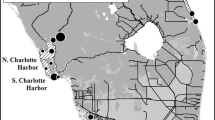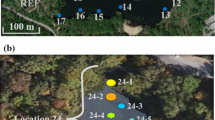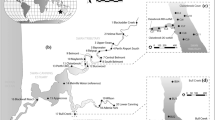Abstract
The goals of this study were to assess the results of a suite of sediment and water column bioassays in the framework of a toxicological risk ranking model and evaluate correlations of model output with fish community metrics. The test sites were located in four tributaries of Chesapeake Bay that are impacted on by industrial, urban and agricultural land use (Curtis Creek, Rock Creek, Fishing Bay and Wicomico River). The mortality, reproduction and growth rates in the water column assays indicated low-level chemical contamination impacts in Curtis Creek and Rock Creek. The results from the Wicomico River and Fishing Bay did not indicate contaminant impacts, but some borderline effects were seen. The sediment bioassays demonstrated greater toxicological responses than the water column assays. The sediments in the Curtis Creek and Rock Creek sites were contaminated with heavy metals and PAHs. The heavy metal concentrations were an order of magnitude lower in the Fishing Bay sediments and below detection in the Wicomico River sediments, except for zinc. The acid-volatile sulphides:simultaneously extractable metals (AVS:SEM) ratios were below 1 in all cases. All four systems had detectable petroleum hydrocarbon contamination. Organic contaminants were below detection for all analyses in the Wicomico River and Fishing Bay samples. The risk ranking model ranked Curtis Creek as the most toxicologically impacted site, followed by Rock Creek, Fishing Bay and Wicomico River, which were essentially equal. The diversity index for fish communities sampled by bottom trawl was significantly correlated with the toxicological risk scores for sediment. The toxicological results indicate sediment contamination effects on the deep water fish community in Curtis Creek and indicate that contaminant impacts are not likely to be a contributing factor to disturbed fish communities in Fishing Bay
Similar content being viewed by others
References
ASTM (1990) In J. Lambertson and R. Swartz (eds) Guide for conducting 10-day static sediment toxicity tests with marine and estuarine amphipods. Standard E-1367. Philadelphia, PA: ASTM.
Carmichael, J., Richardson, B. and Jordan, S. (1992a) Development and Testing of Measures of Ecological Integrity and Habitat Quality for Chesapeake Bay Tributaries. Annapolis, MD: Maryland Department of Natural Resources, Tidewater Administration, Chesapeake Bay Research and Monitoring Division.
Carmichael, J., Richardson, B., Roberts, M. and Jordan, S. (1992b) Fish Sampling in Eight Chesapeake Bay Tributaries. Annapolis, MD: Maryland Department of Natural Resources, Tidewater Administration, Chesapeake Bay Research and Monitoring Division.
DeWitt, T.H., Redmond, M.S., Sewall, J.E. and Swartz, R.C. (1992) Development of a Chronic Sediment Toxicity Test for Marine Benthic Amphipods. Annapolis, MD: Chesapeake Bay Program Office.
DiToro, D.M., Mahony, J.D., Hansen, D.J., Scott, K.L., Hicks, M.B., Mayr, S.M. and Redmond, M.S. (1990) Toxicity of cadmium in sediment: the role of acid volatile sulfide. Environ. Toxicol Chem. 9, 1489–504.
DiToro, D.M., Mahony, J.D., Hansen, D.J., Scott, K.L., Carlson, A. and Ankley, G. (1992) Acid volatile sulfide predicts the acute toxicity of cadmium and nickel in sediments. Environ. Sci. Technol. 26, 96–101.
Hall, L.W., Jr, Ziegenfuss, M.C., Fischer, S.A., Alden, R.W., III, Deaver, E., Gooch, J. and Debert-Hastings, N. (1991) A Pilot Study for Ambient Toxicity Testing in Chesapeake Bay. Annapolis, MD: US Environmental Protection Agency, Chesapeake Bay Program Office.
Hall, L.W., Jr, Ziegenfuss, M.C., Fischer, S.A., Anderson, R.D., Killen, W.D., Alden, R.W., III, Deaver, E., Gooch, J. and Debert-Hastings, N. (1994) A Pilot Study for Ambient Toxicity Testing in Chesapeake Bay.
Hartwell, S.I. (1989). Risk assessment. In E.C. Krome (ed.) Chesapeake Bay ambient toxicity assessment workshop report. Annapolis, MD: US Environmental Protection Agency, Chesapeake Bay Program Office.
Hartwell, S.I. (1997) Demonstration of a toxicological risk ranking model to correlate measures of ambient toxicity and fish community diversity. Environ. Toxicol. Chem. 16, 361–71.
Hartwell, S.I., Wright, D.A., Takacs, R. and Hocutt, C.H. (1991) Relative respiration and feeding rates of oyster and brackish water clam in variously contaminated waters. Mar. Pollut. Bull. 22(4), 191–7.
Hartwell, S.I., Wright, D.A. and Savitz, J.D. (1993) Relative sensitivity of survival, growth and reproduction of Eurytemora affinis (Copepoda) for assessing polluted estuaries. J. Water Air Soil Pollut. 71, 281–91.
Hartwell, S.I., Dawson, C.O., Jordahl, D.M. and Durell, E.Q. (1995) Demonstration of a Method to Correlate Measures of Ambient Toxicity and Fish Community Diversity. Annapolis, MD: Maryland Department of Natural Resources, Chesapeake Bay Research and Monitoring Division.
Jordan, S.J., Vaas, P. and Uphoff, J. (1991) Fish assemblages as indicators of environmental quality in northern Chesapeake Bay. In Biological criteria: research and regulation 1990.
Jordan, S.J., Stenger, C., McGinty, M., Arnold, T., Ives, S., Randall, D., Rodney, B. and Hartwell, S.I. (1994) Estuarine Habitat Assessment and Index of Biotic Integrity Demonstration and Testing.
Karr, J.R. (1981) Assessment of biotic integrity using fish communities. Fisheries 6(6), 21–7.
Logan, D.T. and Wilson, H.T. (1995) An ecological risk assessment method for species exposed to contaminant mixtures. Environ. Toxicol Chem. 14(2), 351–9.
Long, E.R. and Morgan, L.G. (1990) The Potential for Biological Effects of Sediment-sorbed Contaminants Tested in the National Status and Trends Program. US Department Commerce. Margalef, R. (1958) Information theory in ecology. Soc. Gen. Systems 3, 36–71.
May, E.B., Jensen, W.P. and Jordan, S.J. (1992) Toward the development of a biologically sound philosophy for ecological risk assessment. In R.L. Jolley and R.G.M. Wang (eds) Effective and safe waste management: interfacing sciences and engineering with monitoring and risk analysis. Boca Raton, FL: Lewis Publishers.
US EPA (1979) Handbook for Analytical Quality Control in Water and Wastewater Laboratories. Cincinnati, OH: US Environmental Protection Agency.
US EPA (1991) Methods for Measuring the Acute Toxicity of Effluents and Receiving Waters to Freshwater and Marine Organisms, 4th edn. Washington, DC: Office of Research and Development.
US EPA (1992) Interim Guidance on Interpretation and Implementation of Aquatic Life Criteria for Metals. Washington, DC: Office of Water.
Vaas, P.A. and Jordan, S.J. (1991) Long term trends in abundance indices for 19 species of fish of Chesapeake Bay: reflections of trends in the Bay ecosystem. In J.A. Mihursky and A. Chaney (eds) New perspectives on the Chesapeake system: a research and management partnership. Solomons, MD: Ches. Res. Consort Inc.
Warner, K.A., Hartwell, S.I., Mihursky, J.A., Zimmerman, C.F. and Chaney, A. (1991) The Lower Patapsco River/Baltimore Harbor Contaminant Data Base Assessment Project. Solomons, MD: Chesapeake Research Consortium.
Wright, D.A., Hocutt, C.H. and Hartwell, S.I. (1989) Bioassessment of Pollutant Stress in Chesapeake Bay Organisms.
Wright, D.A., Hartwell, S.I. and Savitz, J.D. (1992) Low-level effects of toxic chemicals on Chesapeake Bay organisms. In Scientific and Technical Advisory Committee of the Chesapeake Bay Program (ed.) Perspectives on Chesapeake Bay, 1992: advances in estuarine sciences. CRC Publication.
Author information
Authors and Affiliations
Rights and permissions
About this article
Cite this article
Ian Hartwell, S., Dawson, C.E., Durell, E.Q. et al. Integrated measures of ambient toxicity and fish community diversity in Chesapeake Bay tributaries. Ecotoxicology 7, 19–35 (1998). https://doi.org/10.1023/A:1008803600614
Issue Date:
DOI: https://doi.org/10.1023/A:1008803600614




